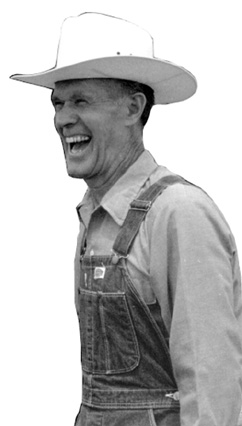 Bernie's
Big Day:
Bernie's
Big Day:With Bare Toes or Sneakers, It's Time to Wade Right In
 Bernie's
Big Day:
Bernie's
Big Day:
With Bare Toes or Sneakers, It's
Time to Wade Right In
At its 10th anniversary, Bernie Fowler's Sneaker Index has given him the most famous feet in Maryland
by Sandra Martin
You just wade out in the river,
give it all you got
Right up to your chest.
And then you pick your spot.
-Tom Wisner's "Bernie Fowler Day: A Guide to Wading in the Southern Maryland Waters"
Back in 1988, a state senator donned coveralls, broad-brimmed farm hat and a pair of white sneakers. Thus clothed, he walked into the river. Now, a full decade later, Bernie Fowler has the most famous feet in Maryland.
Next you take your peepers
And cast them slowly down
On the day we see our feet again
There'll be celebration in this town.
They could have called Bernie Fowler a madman. Instead, they called him a visionary. His wade-in has gained attention far and wide as the clearest measure of the health of Chesapeake Bay. In 1990, The University of Maryland's Center for Environmental Studies honored him with its first Truitt Environmental Award. In 1993, Tom Horton introduced National Geographic readers to Bernie in his cover story on the Chesapeake. In 1994, the Maryland General Assembly designated the traditional wade-in day, the second Sunday in June, as Bernie Fowler Day.
"It's a wonderful way to bring people together and increase and hold attention on water quality," said Kent Mountford, senior scientist at U.S. Environmental Protection Agency's Bay Office, himself an observer of the lower Bay and Patuxent River for over 28 years.
This year, as its 10th anniversary rolls around, Bernie's sneaker test is spreading from the wide, southern Patuxent River to the whitewater of the upper Potomac River, from shallow, central Herring Bay to northerly Otter Point Creek at the Bush River in Harford County.
It's Bernie's measure!
It's simple - yet profound.
We got a treasure!
You can't buy it by the pound.
It's not hard to understand why Bernie's sneaker test caught on. Chesapeake Bay casts a spell over most everybody, newcomer or oldtimer, touched by its waters, and people throughout the watershed have pitched in to bring their beloved waters back to good health. But recovery is typically measured in the equations of scientists and expressed in the language of bureaucrats, leaving even the best-intentioned Bay friends scratching their heads.
The scientists had told them
Everything they knew,
Still - the folks were puzzled
And they didn't know what to do.
What Bernie's doing, everybody can understand.
Despite his 30 years in politics, Fowler has never lost touch with what Shakespeare's rival Ben Jonson called "the language men do speak."
Speaking of his beloved boyhood river as chairman of the Patuxent River Commission a couple of years ago, Fowler said "the Patuxent River is still the canary bird of the Chesapeake Bay."
By canary bird, he doesn't, young readers, mean the Patuxent is a pretty river. Coal miners used to carry caged canaries into the deep shafts where they dug for black gold. Those same seams could be full of deadly odorless gases. If the canary died, the miners went running.
"If you can't clean her up," said Fowler, "you're in trouble."
'Cause I ask you what's the profit
If we gain these worldly things
And foul the air and water
And all the life that brings?
So when another plain-speaking friend, Tom Wisner suggested a little wade to Bernie a decade ago, the senator did not say no. Wisner recorded their walk in a poem called "Bernie Fowler Day: A Guide to Wading in the Southern Maryland Waters." Since then, well, the rest is history.
Well - we should do this yearly
On Bernie Fowler Day.
Dress up fit to kill
And wade out all the way.
Beholden to the Bay
To understand what Bernie's doing, it's well to understand where he's coming from. That's the Bay.
Sixty years ago, the young Fowler left the comforts of Calvert County and the Bay's southern shores first to live in Washington, D.C., then to fight in World War II.
After the war, he returned home with a $4,000 G.I. Bill loan to start Bernie's Boats, a rowboat business on Broomes Island with a pier and a snack bar.
"Back then, I was my own bait boy, clerk, everything. Soda bottles - Pepsi, Coke and Nehi, all flavors - were refillable. At the end of each day, I'd stack them outside. One day, when I was doing this, I saw these two customers drive by in their station wagon.
"I waved but didn't pay much attention. As I finished, they parked the car. It wasn't until they approached me that I noticed their daughter, Betty Lou - about my age and the most beautiful thing I had ever laid my eyes on. It was almost love at first sight."
Bernie and Betty Lou have been together 48 years - and never far from the Bay or its great southern tributary, even after he retired from the Maryland Senate in 1994.
From all those years in close touch with land and water, Fowler developed his grassroots environmental consciousness. "Earth was put together with such finesse. Everything we needed was here. All the beautiful resources of the world were here. To allow somebody for selfish reasons to destroy those assets is unconscionable," says the politician who speaks from his heart.
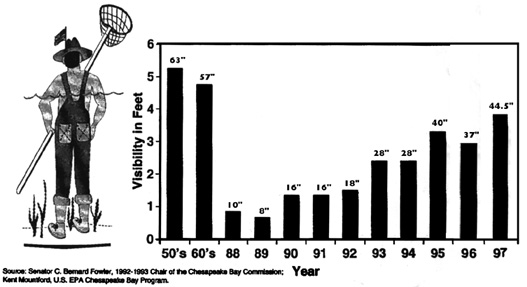
Inching up to Clarity
In the 1950s, Bernie - standing six feet - could walk chest deep into the Patuxent and see crabs swimming by. Visibility, he figured, was a good 63 inches. "It was crystal clear in the '50s," said Fowler. "When I was a young adult, I could wade out there and chase the crabs."
In 1966, he looked down into the water for crabs and came up dry. That's how Fowler knew when the Bay and the Patuxent started taking a turn for the worse.
All the politicians gathered.
They'd come from miles around
To talk about the river
That flows by Solomons town.
Seems they had a problem
Things were looking bad.
They'd looked at all resources
And used everything they had.
By 1970, Fowler was campaigning for a seat as a Calvert County commissioner on a promise to clean up the Patuxent, which he then called one of the most polluted rivers on the East Coast. Upriver sewage treatment plants, discharging what later came to be called "point-source pollution" were the heart of the problem. "Up until 1987 or '88, it was gross," Fowler recalled this week.
Fowler joined a lawsuit filed by Charles, Calvert and St. Mary's counties, eventually forcing the state of Maryland and the U.S. Environmental Protection Agency to live up to the Clean Water Act.
"If you can't see your cloppers
There'll be trouble in this town
We oughta sue those upper counties
For the junk they're sending down."
Then, in 1974, Fowler helped organize 400 community volunteers to write Calvert County's first plan to improve the environment. But the Patuxent wasn't getting much cleaner.
In 1988, Bernie and his friend Tom Wisner waded right into the problem.
It came 'round to Bernie Fowler
And he stood among the best.
He said, "folks, if you'll bear with me,
I think I got a test."
"I think I have a measure
That can't be beat
You just wade out in the river
And look down to see your feet."
At that first wade-in, visibility was down to 10 inches. By 1989, the second year of Fowler's sneaker test, the water was so murky he could see only eight inches down.
By 1992, all the attention focused on Chesapeake Bay seemed to be turning the tide. Visibility had crept up to 18 inches.
Bernie Fowler, left, and Tom Wisner with
friends at the 1993 wade-in, at right.
1993 - 1997: 16.5"
We first caught up with Bernie in 1993, when 30 people joined hands on the beach at Broomes Island and walked into the water. That year, Fowler - joined by Wisner, the much shorter U.S. Sen. Barbara Mikulski and, as usual, Betty Brady's fifth-grade class from Hollywood, Maryland - could spot a glimmer of his white tennis shoes while water lapped around his thighs.
In the cool, mushy sand, aquatic grass waved. A walker bent down to pluck a piece and give it to Fowler, who held it aloft triumphantly.
"The grass that the old red-headed ducks feed on is coming back," Fowler said. "The year before last when we saw that, that's the first that we'd seen in over 25 years. We're beginning to see signs of it coming back. That's very encouraging. Aquatic species like that, you can use as a measure that is a little more effective than me looking at my feet."
The senator was pleased but cautious.
"We've still got a long way to go," he said. Today is not a day to say we've won our battle."
In 1994, joining Bernie was Sen. "American Joe" Miedusiewski. As well as wading, the two were running for the Democratic Party's nomination to lead Maryland, "American Joe" as governor, Bernie as lieutenant governor.
"Sunday was a good day for a wade-in, bright and sunny. But not for good results," said Fowler. "A Southeaster Saturday night stirred the water up. We couldn't see below our knees." Official visibility was 28 inches.
Peering down through the brown waters of the Patuxent River at his white sneakers in 1995, Bernie Fowler saw 12 more inches of long leg. In that watermark year, visibility rose to 40 inches.
Visibility was down a couple of inches in 1996, likely because of waves or water turbulence, but participation was up. Close to 100 joined hands and walked into the water, keeping watch on their toes.
"Forty-four and a half inches." With those words, U.S. EPA Administrator Carol Browner announced the results of 1997's Bernie Fowler Day.
"That's a 20 percent improvement," announced Congressman Steny Hoyer, who held the tape measure up to Fowler's water-stained indigo overalls. In the crowd of nearly 200 people, about 75 actually waded into the luke-warm water.
Mingling with concerned citizens were a number of Maryland's most familiar names. In addition to Hoyer and Browner, Maryland's Senate President Thomas V. "Mike" Miller showed up - although he remained dry in suit and tie, begging out due to additional commitments. Wading in alongside Fowler were Maryland comptroller Louis Goldstein, Maryland's Secretary of the Environment Jane Nishida, as well as representatives from both Calvert and St. Mary's Counties.
Political heavy-hitters regularly join hands with Fowler to wade in, but 1997 may have marked a political watershed. "We had a power base here that is probably the largest we've ever had," Fowler said.
Folwer and U.S. Senator Barbara Mikulski chat before getting wet, below.
Getting to the Bottom of the Problem
What's beneath 44 and one-half inches of clear water?
Bernie Fowler doesn't pretend to be a scientist, but he can make the
forces behind the turn-around pretty clear. Here's what the 74-year-old
wader told us last week: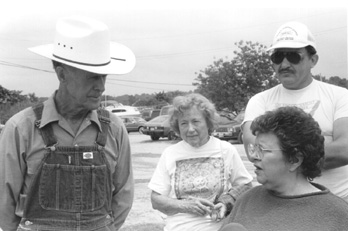
"In the last decade, visibility has increased from 10 inches to 44.5 inches. That represents a tremendous improvement, starting with sewage treatment plants. Most have now retrofitted, taking nitrogen and phosphorus down to acceptable level. That's the major reason."
Nitrogen and phosphorus - chemical by-products of all the people who live, work and play in the Chesapeake's sprawling watershed - are the prime causes of Chesapeake ills. Nitrogen and phosphorus are called nutrients because they act like fertilizer in the Bay. Nitrogen comes from human and animal waste as well as from chemical fertilizers. From old-fashioned sewage treatment plants, faulty septic systems, marine sewage systems, and farm fields, it rushes into the Bay waters through storm water, ground water and erosion. There it fertilizes huge alga crops that devour oxygen, curtain the sun and choke out other Bay life.
In keeping the Chesapeake Bay Agreement of 1984 - the great compact to bring back the Bay signed by Maryland, Virginia, Pennsylvania, the District of Columbia and the federal government - Maryland pledged to reduce nutrients reaching the Bay by 30 percent between 1985 and 2000.
Also helping turn the tide are farmers. "Now in all the Patuxent River critical area, every farm has its best management practice plan. Farmers and the Department of Agriculture have made a commitment to make sure farmers' money spent in fertilizer stays on land and not in river," Fowler said.
Finally, Fowler said, environmental awareness has spread throughout the citizenry: "We've also been able to bring into play school children throughout the state who can talk water quality and environmental language and go home and tell their parents. A more educated public knows it's an unpardonable sin to allow pollution to the Bay and its tributaries or contribute to its demise, and they're thinking of that when they fertilize their lawns or change the oil in their cars."
Toward Critical Mass
Well - we should do this yearly
On Bernie Fowler Day.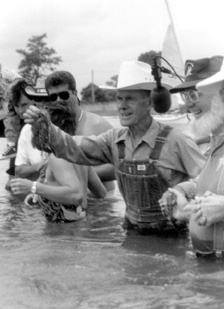
Dress up fit to kill
And wade out all the way.
And somewhere in the future,
We'll look and see our feet again.
Could we ask for more?
That day is coming sure
Fowler displays Bay grasses appearing at the '93 wade-in after a 25-year absence, at right.
"People are networking all around the state so we don't lose momentum to clean up the Bay," Fowler added. Then, turning philosophical: "the Chesapeake is Maryland's heart. If we lose the Bay, the heart stops beating."
What could make people's commitment stronger than wading right into the problem?
The Patuxent wasn't Chesapeake Bay's only tributary, just its best organized. Since 1980, the Patuxent River Commission had studied its problems and sought solutions. Since 1992, under the Chesapeake Bay Plan, all the Bay's major tributaries have had their own commissions.
Bernie invited them all to his 1997 wade-in. His plan: "getting all nine heads of the strategy teams to wade out at the same time on the same day."
"So much of the work on the Bay doesn't get to ground level, while this wade-in actually has people going right into the resource. It really brings it home," says Rich Hall of Maryland Office of Planning, who works with the Patuxent River Commission and on wade-ins.
Fowler must have been moderately successful, because instead of one wade-in, this June 14, we will see four.
One, in the white waters of the upper Potomac at Rocky Gap near Cumberland, where wading can be life-threatening, is actually a fish-in to the theme of get hooked on clean water.
The nearest will bring perhaps 100 waders into Herring Bay from the Owing Cliffs beach at Fairhaven. Leading them in is local Del. George Owings III, who grew up on the Bay at North Beach and who meets outreach organizer Hall's criteria of "a colorful leader with local history."
"It's exciting that it has expanded to regions other than the Broomes Island spot Sen. Fowler - since the 1970s one of leading proponents of Bay clean-up - has used for many years to bring attention to the conditions of tributaries as well as the Bay," said Del. Owings.
Joining Owings is Del. Virginia Clagett, of the next district up the
Bay, who spent her early married life on Herring Bay. Steuart Chaney, co-chairman
of the Lower Western Shore Tributary Team as well as the owner of Herrington
Harbour Marinas, which att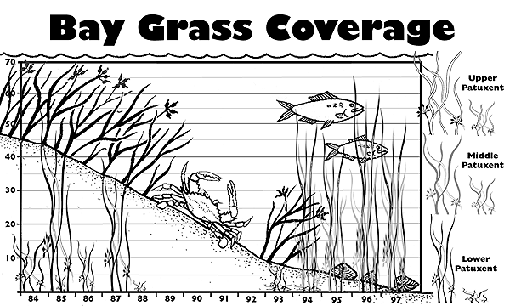 ract
thousands of boats to Herring Bay, will emcee the noon wade-in, which, in
honor of Flag Day, will start with the Pledge of Allegiance. In honor of
Fairhaven's community spirit, it will end with lemonade, served by the Owings
Cliffs Citizen Association.
ract
thousands of boats to Herring Bay, will emcee the noon wade-in, which, in
honor of Flag Day, will start with the Pledge of Allegiance. In honor of
Fairhaven's community spirit, it will end with lemonade, served by the Owings
Cliffs Citizen Association.
"Wear white tennis shoes and bring a towel. Come on time; we don't expect it to take longer than a half hour. Parking is marked on the road," said Peg Burroughs, local wade-in organizer for the Lower Western Shore Team.
From small beginnings great things are hoped.
"Our whole team is working on one big initiative, the Herring Bay Watershed Clean-Water Initiative. We'd be looking at where all the water comes from - farms, the town of Deale, suburban areas, storm areas, septics, boats, marinas, businesses; what it brings and what we can do about it - plus planting on stream buffers and Steuart Chaney's proposal for making Herring Bay a no-discharge zone for boating sewage. We've gotten a small grant from the Chesapeake Bay Trust and Save Our Streams to take a look at the whole watershed. We want to cover everything," said Burroughs.
Getting people that excited about the state and fate of their waters is what Bernie's wade-in is really all about. From there, maybe the tide really can be turned. In the Patuxent, the farthest along of all Chesapeake tributaries, scientist Mountford sees progress.
"We've removed about half of the sources of nutrients, which is a good sign for the river in future," he said.
Fewer nutrients make a big difference, but not a directly visible one. One sign of that improvement that you can see is the return of Bay grasses. "We've made a concerted effort to reduce nitrogen and phosphorus, and we've seen the grasses coming back," said Bruce Michael, Department of Natural Resources' chief of water and habitat quality program. "The Patuxent is one of our success stories."
However, he quickly cautioned, "We certainly have room to continue."
Said Fowler: "That's why we do it every year. People need to be reminded."
It's Bernie's measure,
And it ain't hard to do.
It's a pleasure!
And it will soothe you too.
| Back to Archives |
VolumeVI Number 23
June 11-17, 1998
New Bay Times
| Homepage |